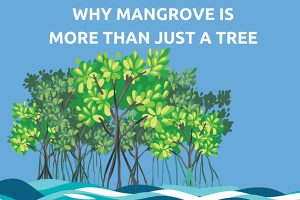The Water Fund Project at the Western Area Peninsula has kicked off some time ago. It is not a secret that the Western Area Peninsula Forest is crucial for the water supply for Freetown and the whole peninsula. But still it is challenging to stop deforestation and encroachment in this area. Through the Water Fund communities, government and civil society learn and work together for sustainable use of water and reforestation to protect water catchments. The Catholic Relief Services (CRS) is the leading organization for the implementation of the Water Fund at the peninsula – but of course – as the oldest environmental organization in the country, the Conservation Society of Sierra Leone (CSSL) is part of the implementation. Last week activities were conducted in the communities at Tombo and Madina with the support of CSSL.
I can now operate the tree tracker app for tracking the number of trees on my mobile phone without the help of any technical person and I now know the process and all what is involve of tree planting.
Aminata- Tombo Community
Tombo community is one out of 14 communities around the Western Area Peninsula where the Water Fund Project is implemented. One of the activities rolled out through the Water Fund Project were trainings for community members on how to sustainably restore the forest around the peninsula and how to track the trees with a mobile app. The aims of the Water Fund Project are to increase community awareness, participation and capacity in catchment protection and management and to promote reforestation using economic and fast-growing trees near or along the demarcated areas for water management, soil, biodiversity, and energy needs.
Catholic Relief Services (CRS) is the leading organization for the Water Fund Project. CRS signed a grant with The Nature for Conservancy (TNC) to complement and accelerate ongoing investments by CRS through implementing pilot projects with diverse stakeholders led by the National Water Resources Management Agency (NWRMA). CRS continues to lead efforts to engage stakeholders in concrete action including formation of catchment management committees, who facilitate community action in physical demarcation of protected areas and learning for scale up.
What is a Water Fund
Water funds unite the public and private sectors and civil society around the common goal of securing water. Downstream water users – businesses, utilities, and governments – financially support the water fund, along with international donors. These funds benefit upstream farmers, landholders, and communities by paying for conservation activities, such as reforestation, enhancing forest protection, or restoring wetlands that filter pollution. Water users then benefit from improved water quality and quantity. Over the last two decades, The Nature Conservancy (TNC) and partners have successfully created water funds in more than 43 cities around the world, including Cape Town and Nairobi.
Joint forces to protect Western Area Peninsula Forest
The Conservation Society of Sierra Leone (CSSL) with other CSOs and some government institutions that are responsible for the protection and law enforcement of the national parks joined CRS for this important and remarkable project over the last months. The latest activity of the Water Fund Project team was a three-day community engagement around the Western Area Peninsula. The objective of the engagement was to present and explain the map of areas as green belt and protected by government. During the engagements the technical experts who will be working with the communities to install the pillars along the demarcated areas were introduced to the community members. During the discussions, it came out clear that Tombo community which has planted about thirty thousand (30,000) trees around the catchment areas is ready for the Water Fund Project team and the government to install pillars along the demarcated area. By the end of the meeting the headman of Tombo draw the attention of the Water Fund Project team to the fact that only one part of the hill belongs to the Tombo community, the other one belongs to Madina community, and the project team will have to talk to their headman separately.
Following up on this important information a meeting was held in Madina community some days later. The project officer of CRS presented the map with demarcated and protected areas to the headman and some of his local authorities. He also explained the plans about installing pillars around the demarcated areas of the forest and its importance. After the presentation the team concluded a site visit together with the headman, his chiefs and further community members to show the exact borders where the pillars will be set up. This site visit showed that some parts of the land inside the demarcated area has already been sold by one of the chiefs. But the headman still gave his agreement for the continuation of the demarcation work and the said chief must present his case to the Ministry of Lands and National Protected Area Authority (NPAA). The representative from the Ministry of Lands shared his contacts with the community members so that everyone with a legal document should contact him or take it to the ministry for solutions.
This incident shows how important good collaboration and joint action is for the successful protection of the Western Area Peninsula Forest and the water catchment areas on the hills of Freetown. Due to the involvement of important key stakeholders and decision makers from government and civil society the Water Fund Project was able to reach a fast solution for an unforeseen challenge. Community members like Aminata in Tombo are motivated and strongly engaged in the project objectives and they obviously have been taken ownership. Hopefully this enthusiasm for the protection of the demarcated areas and the forest will spread around the peninsula also to those communities who have not been part of the trainings through CRS and its partners.
More information about the Water Fund are available in these documents:



